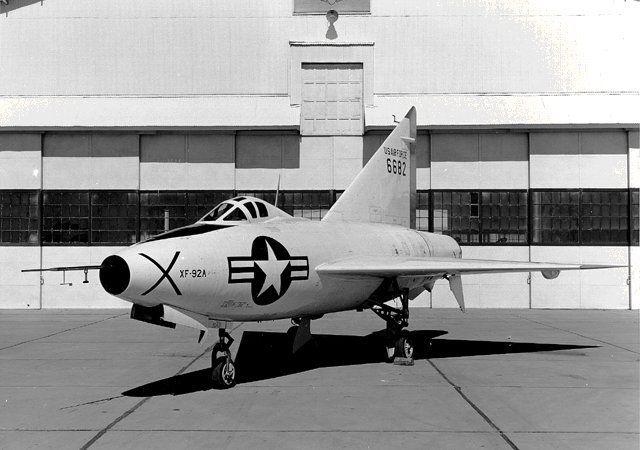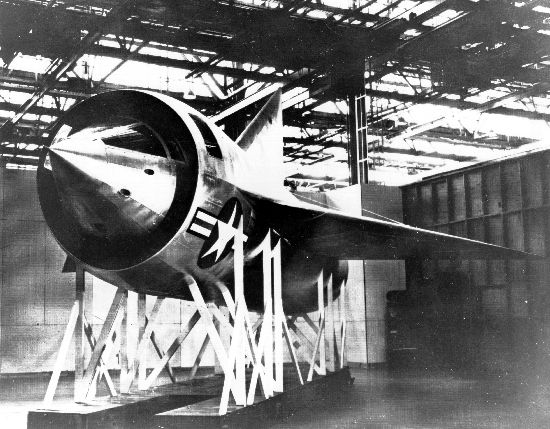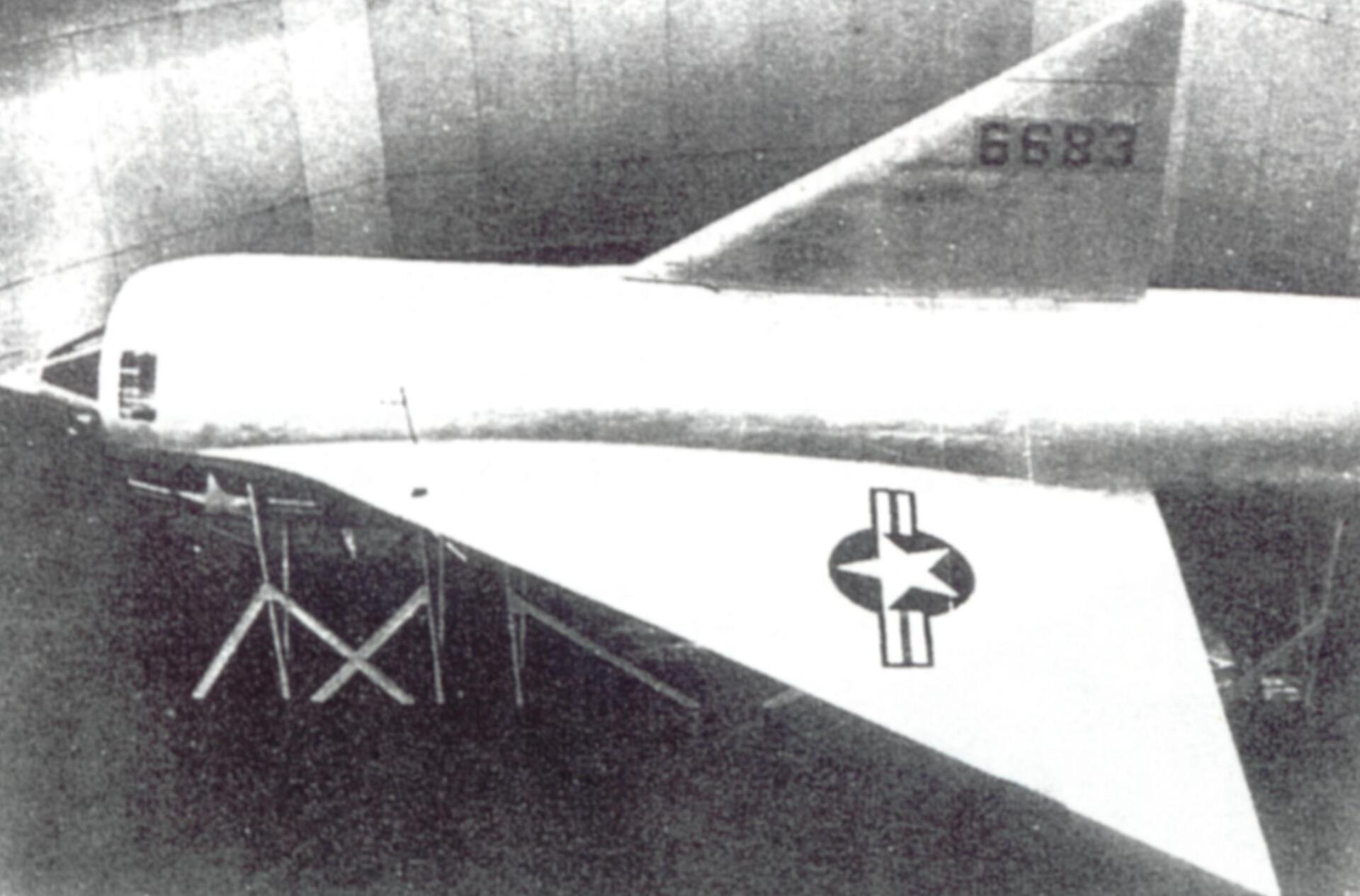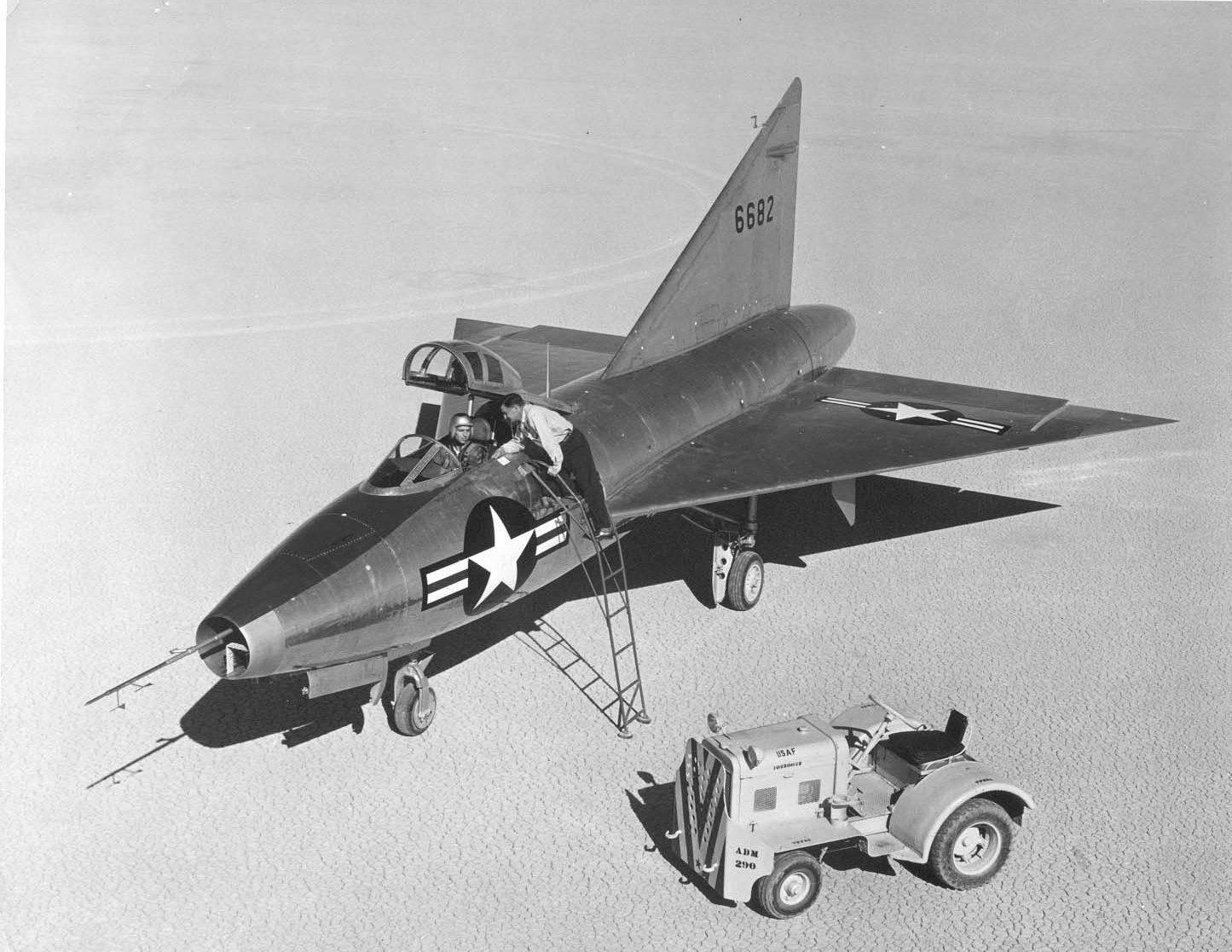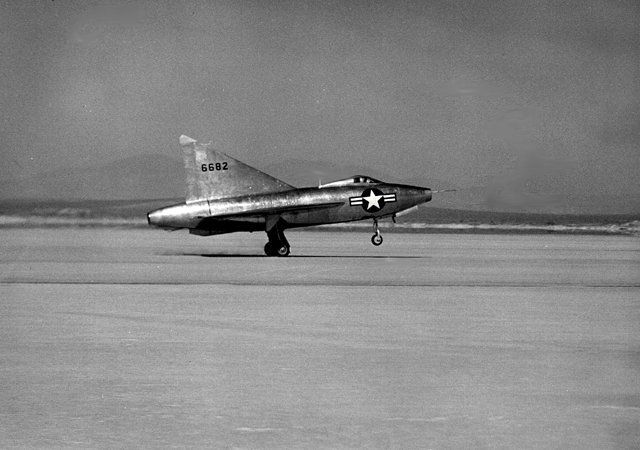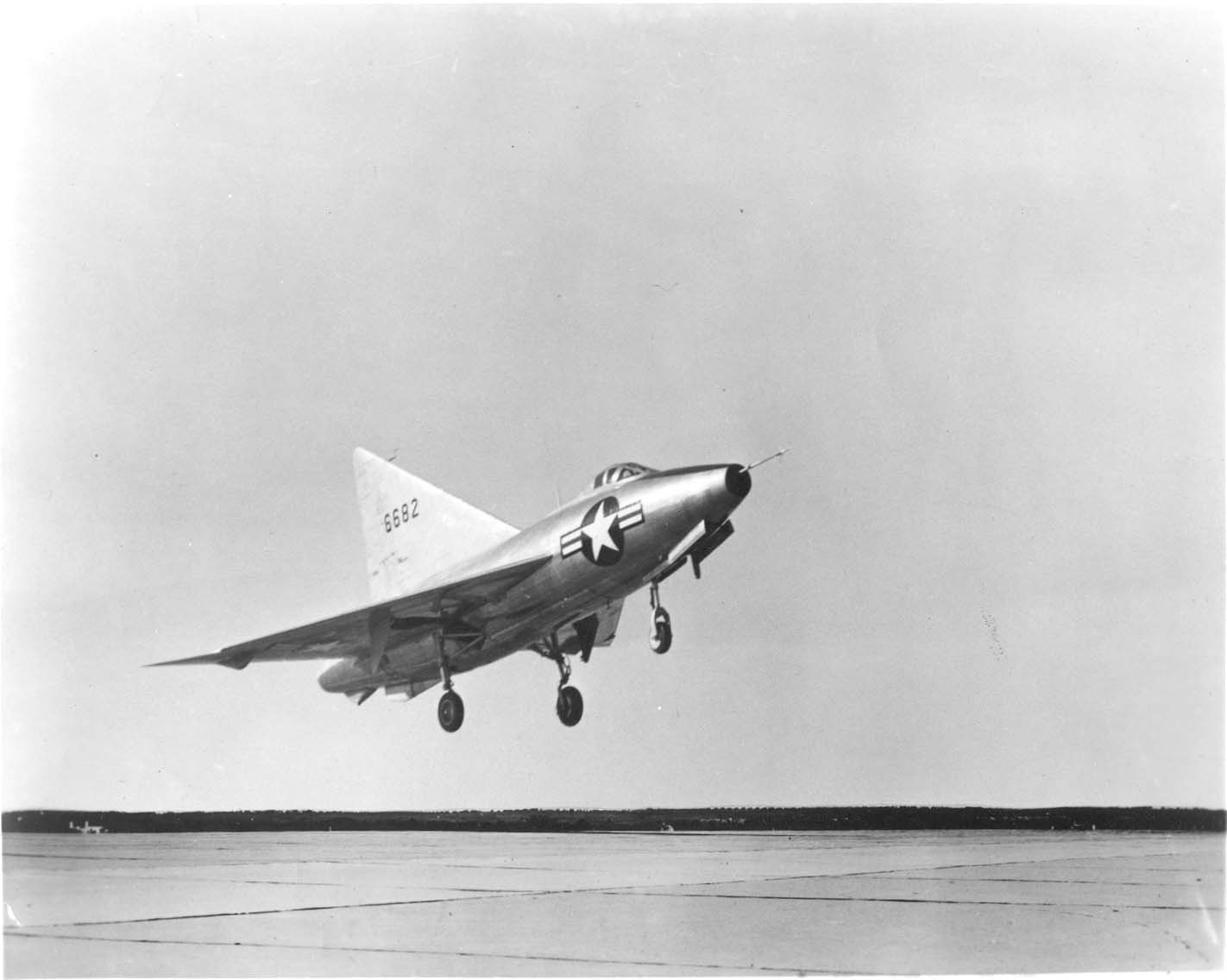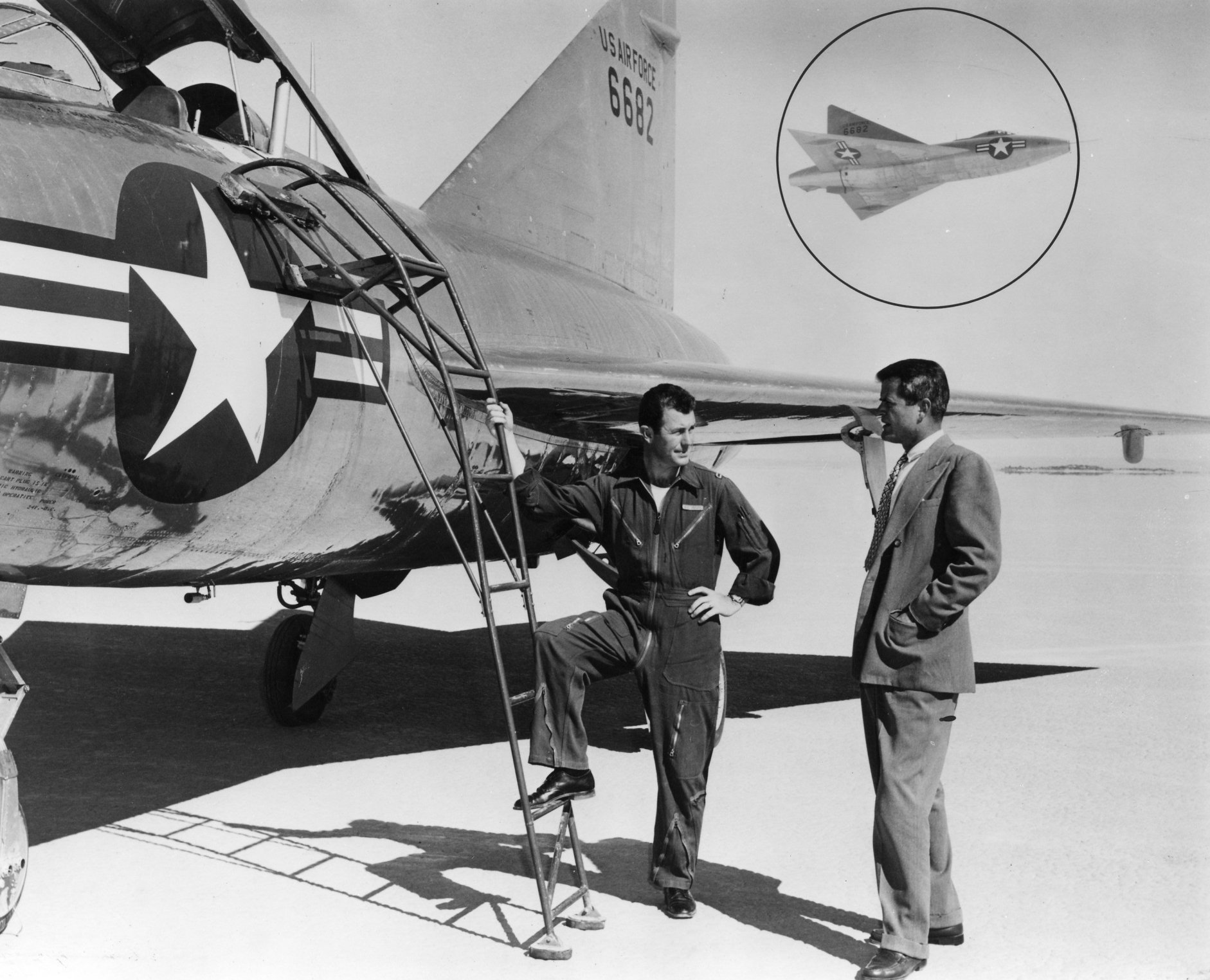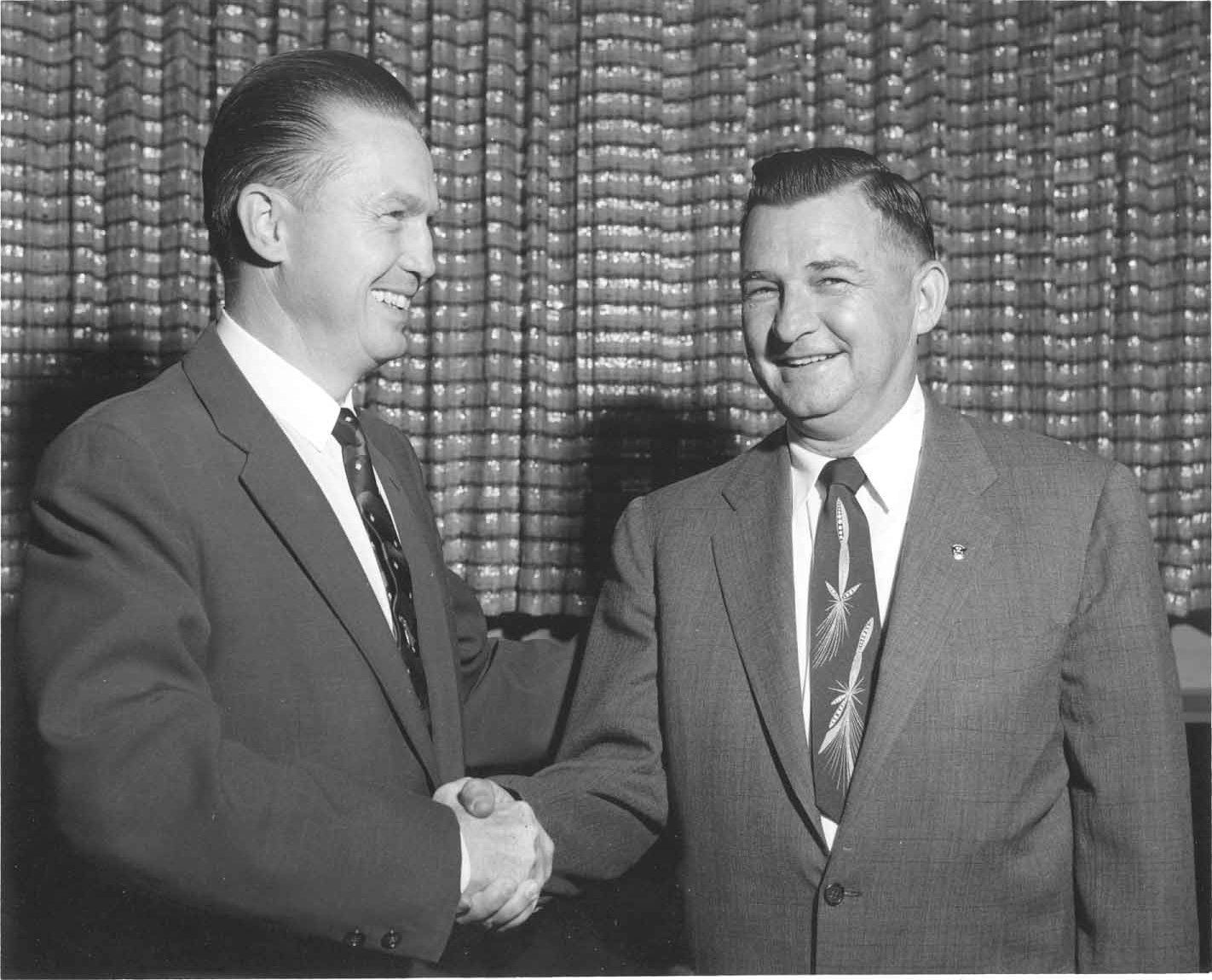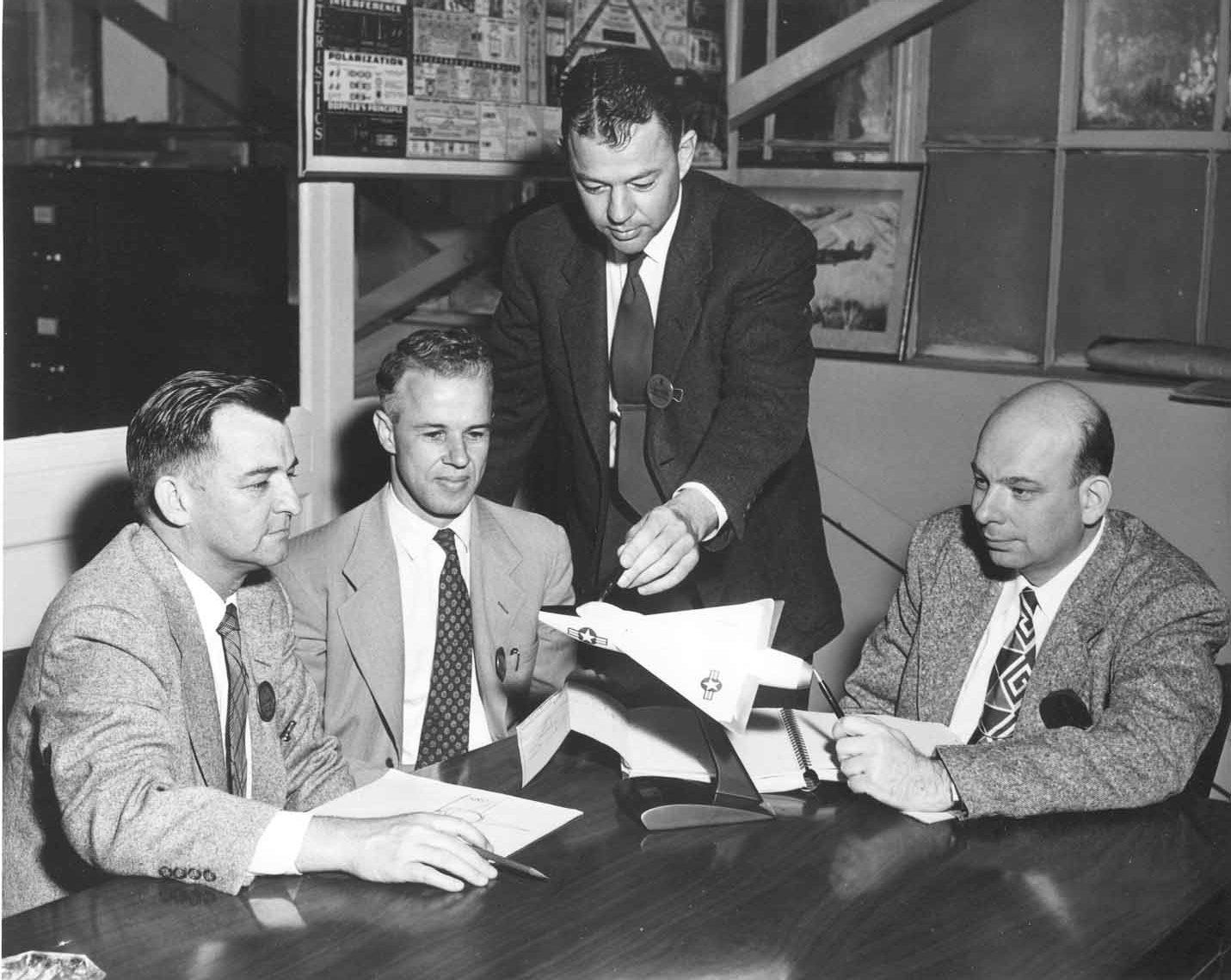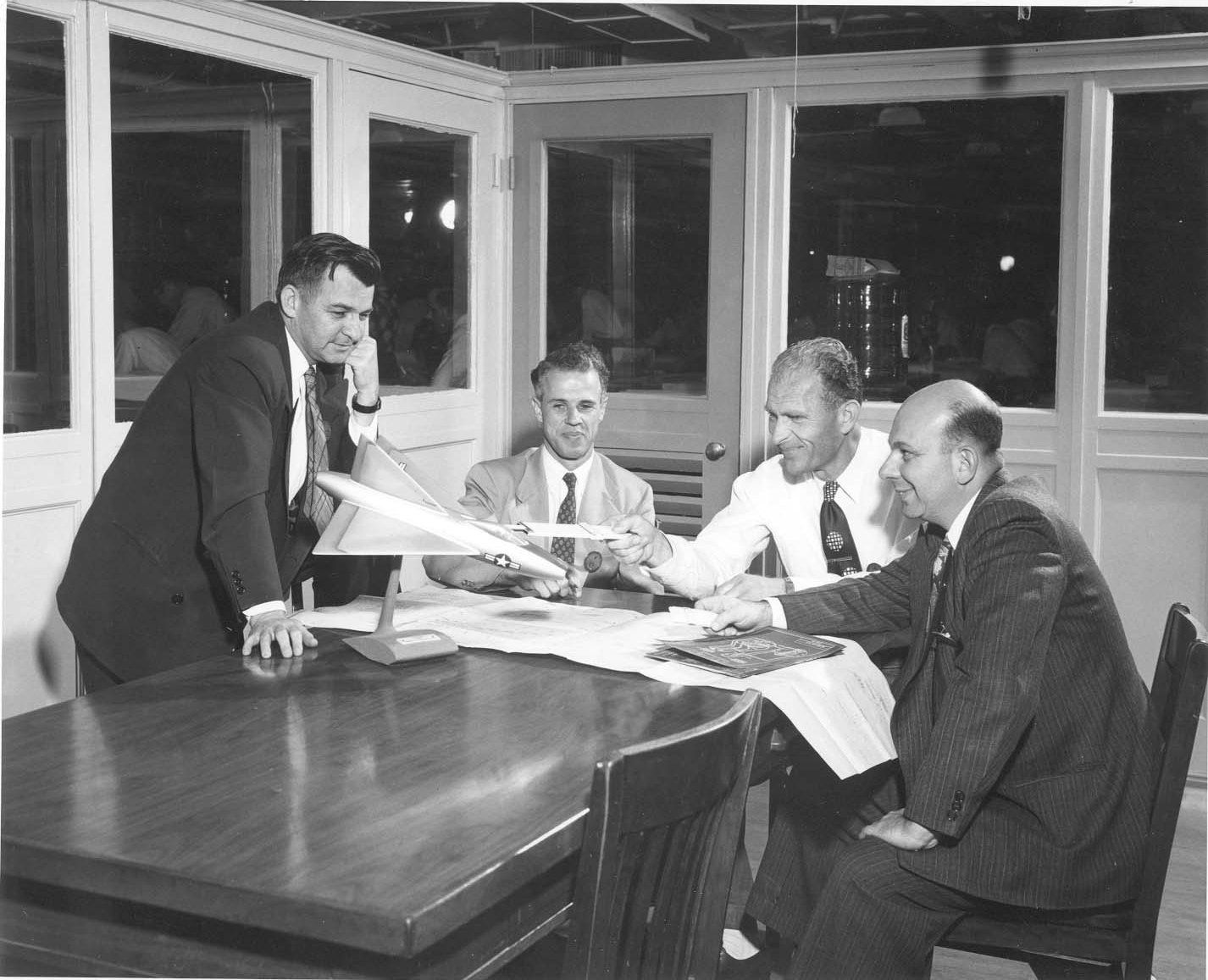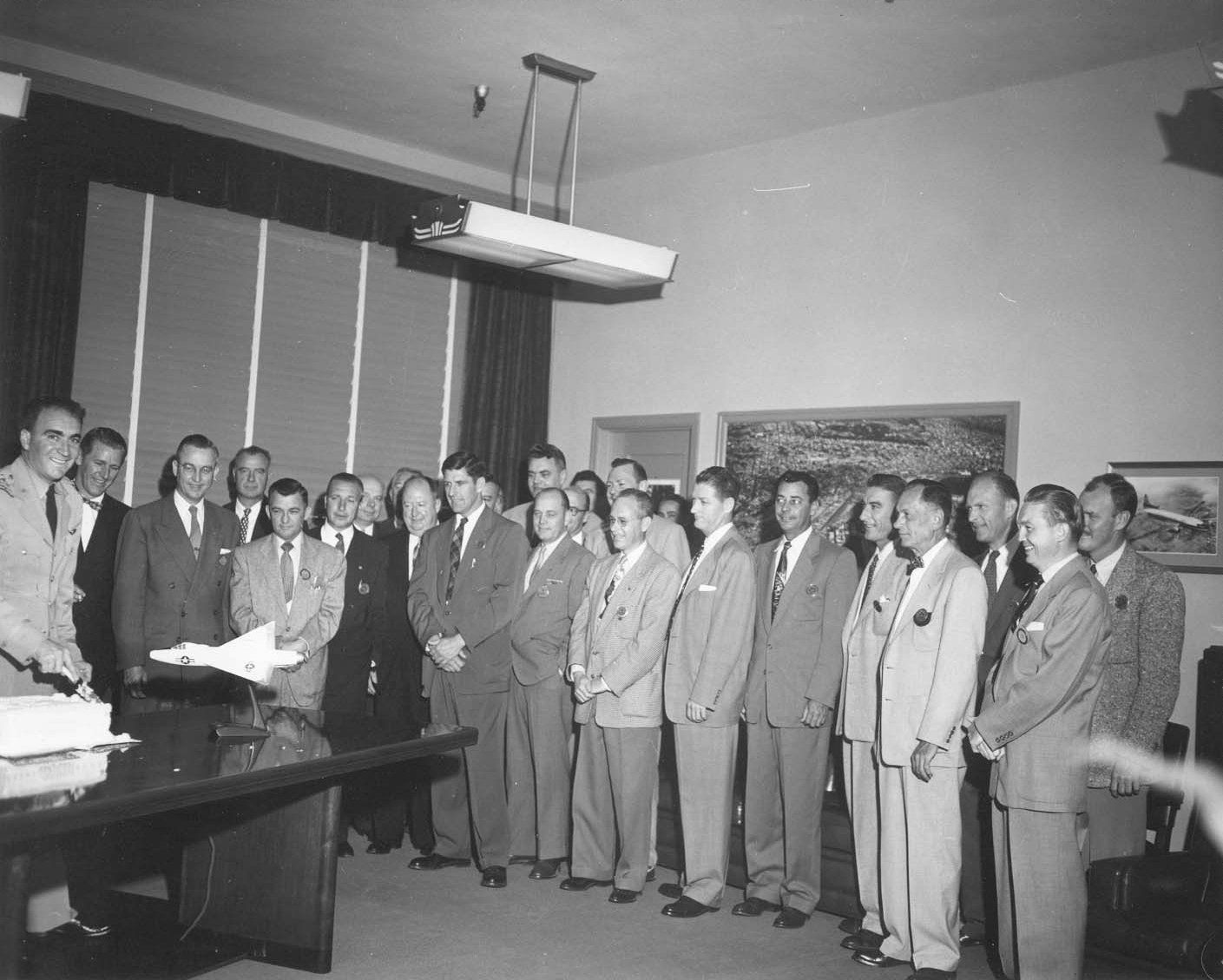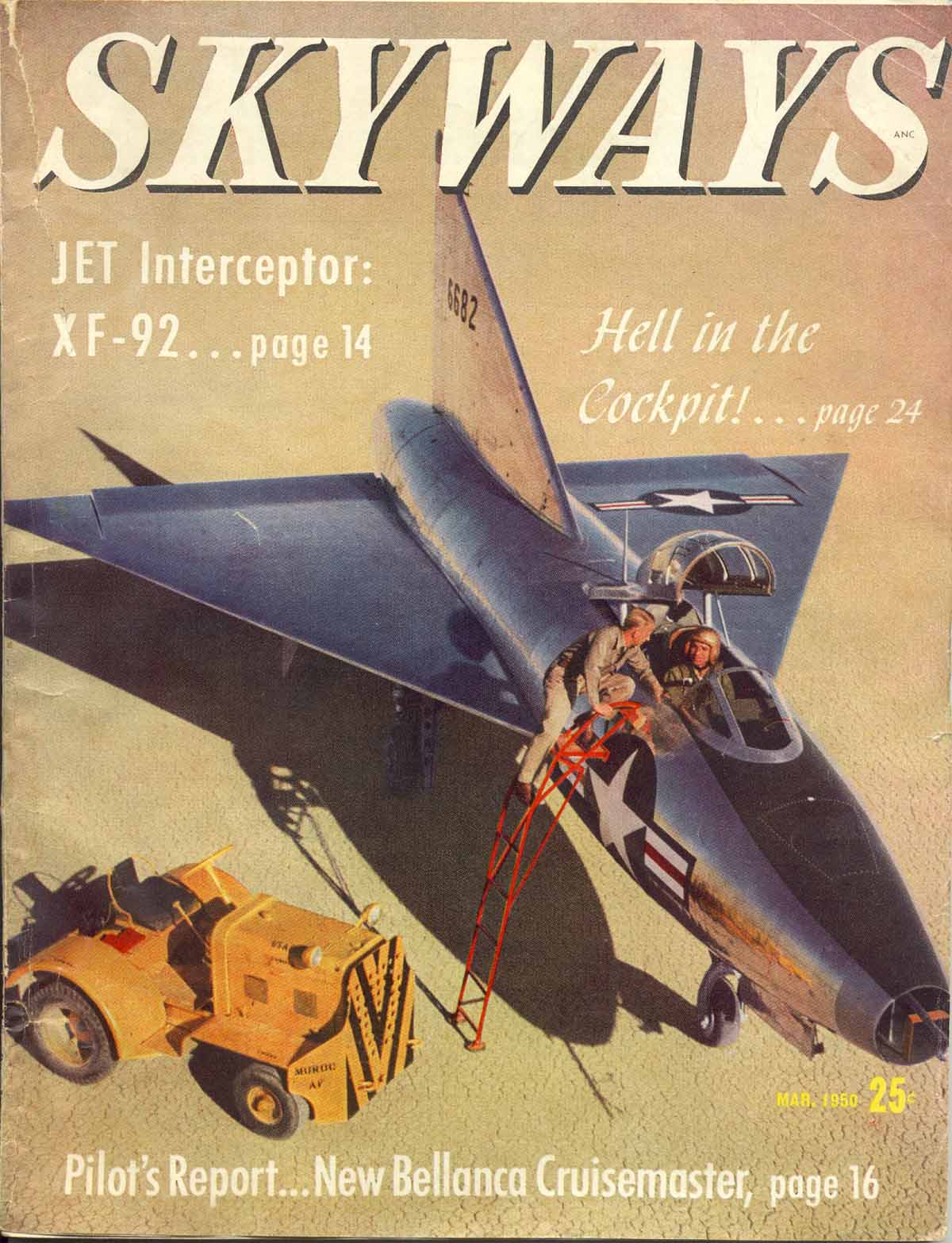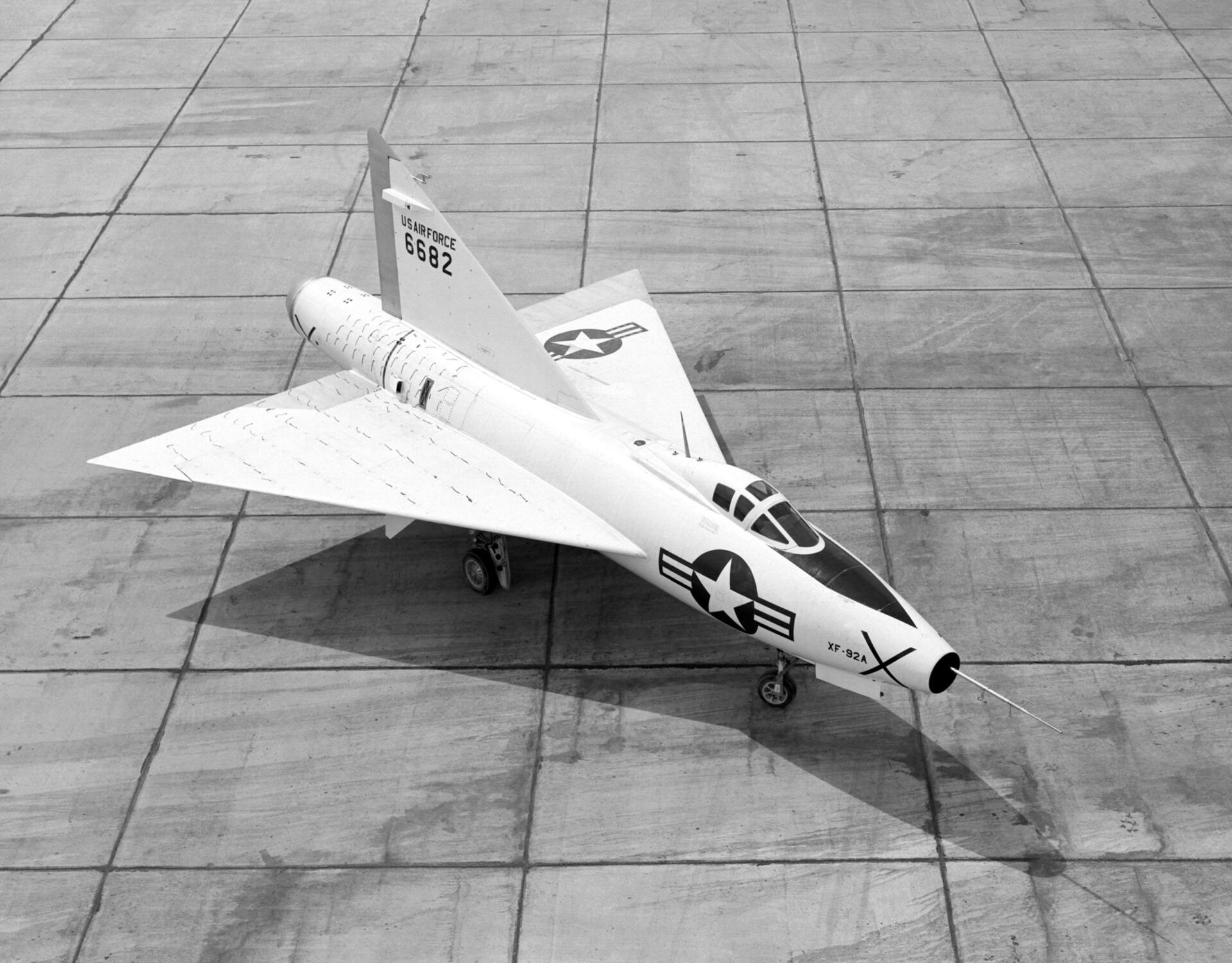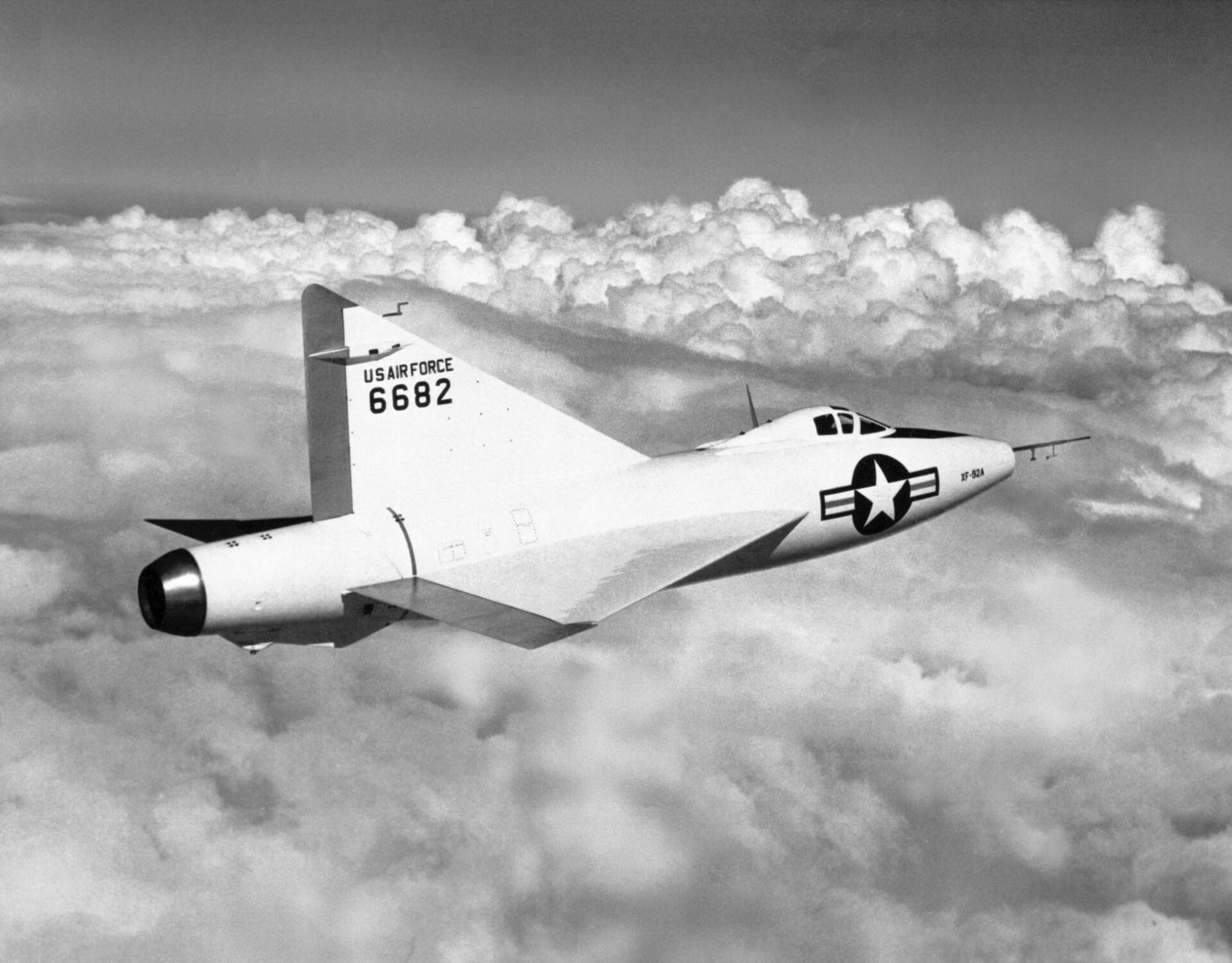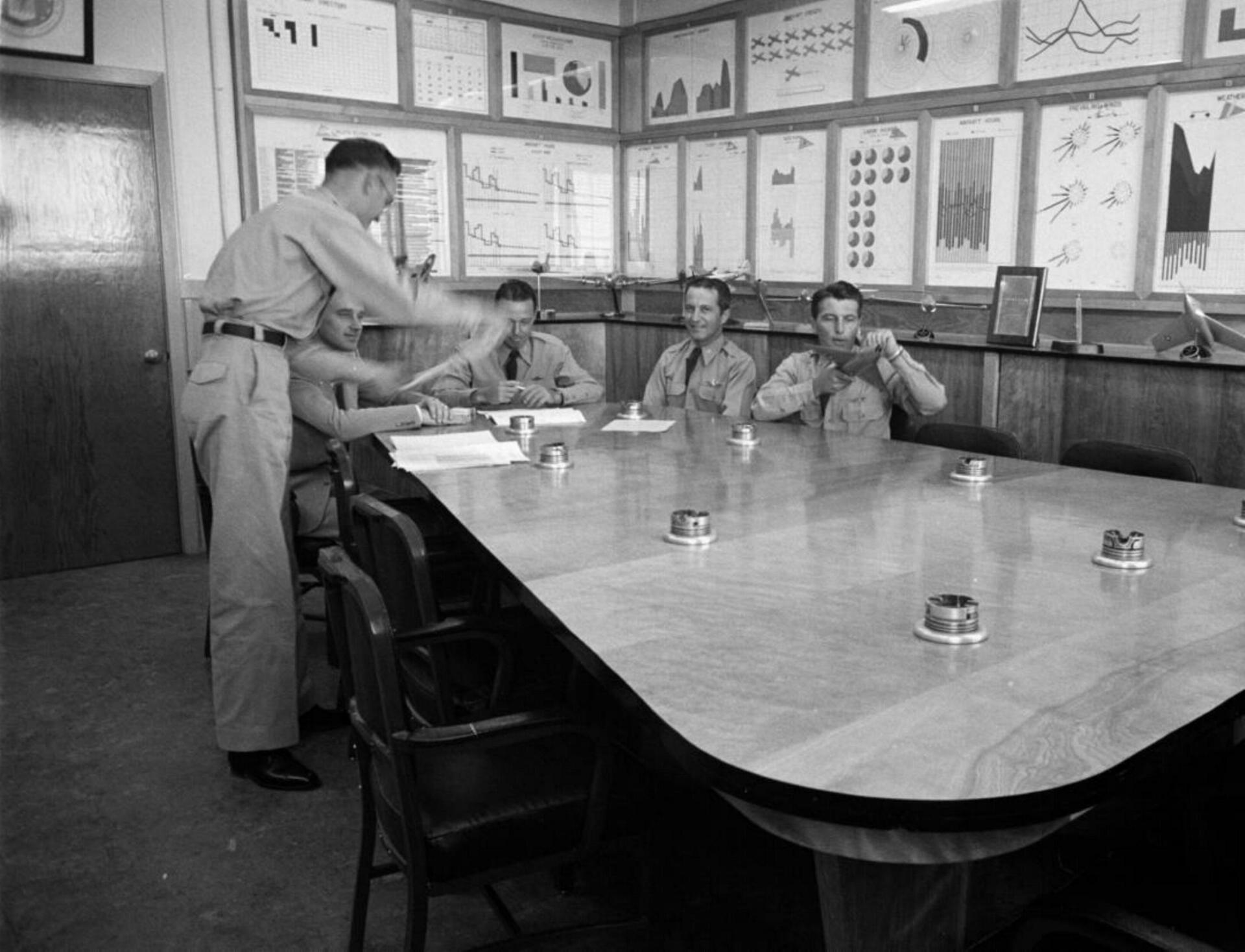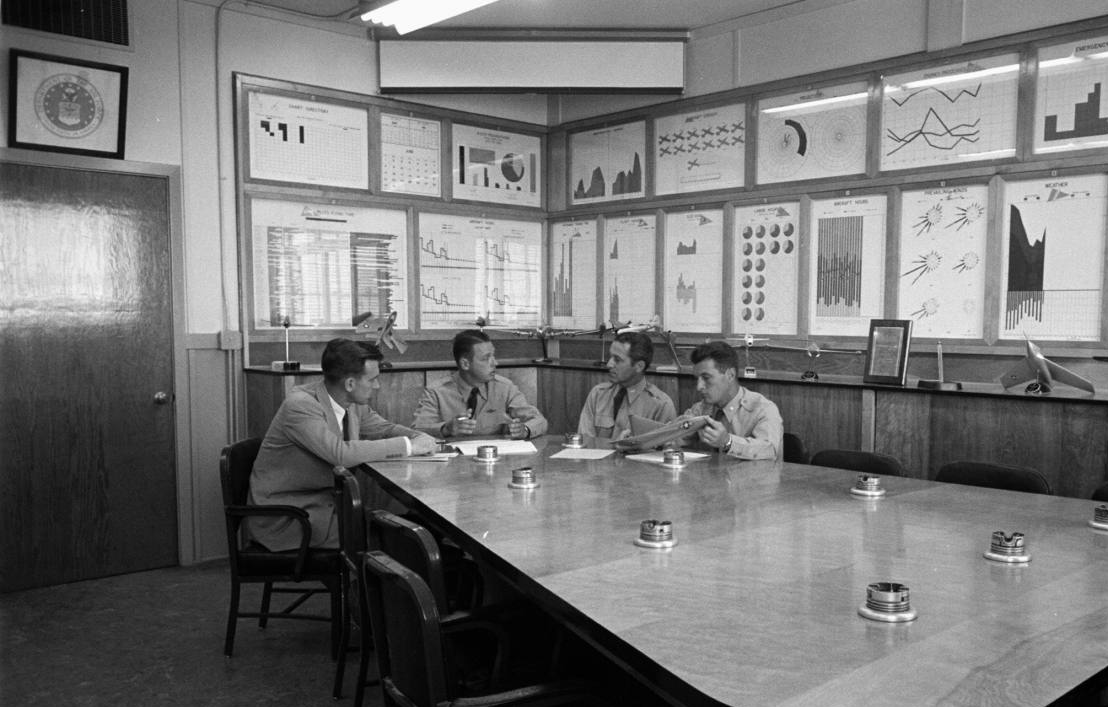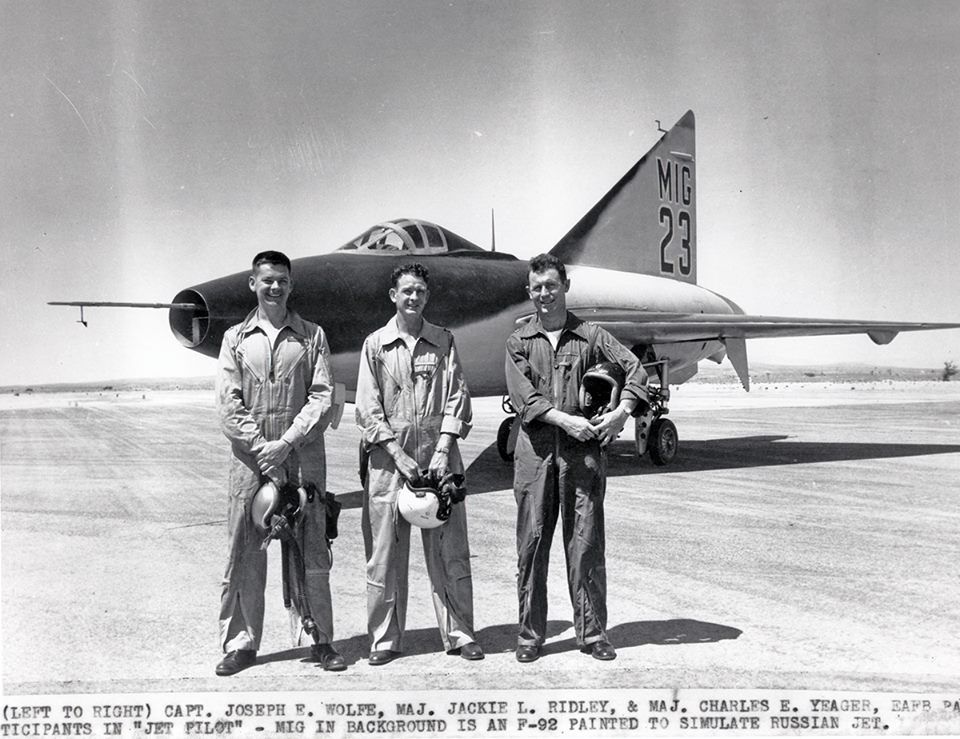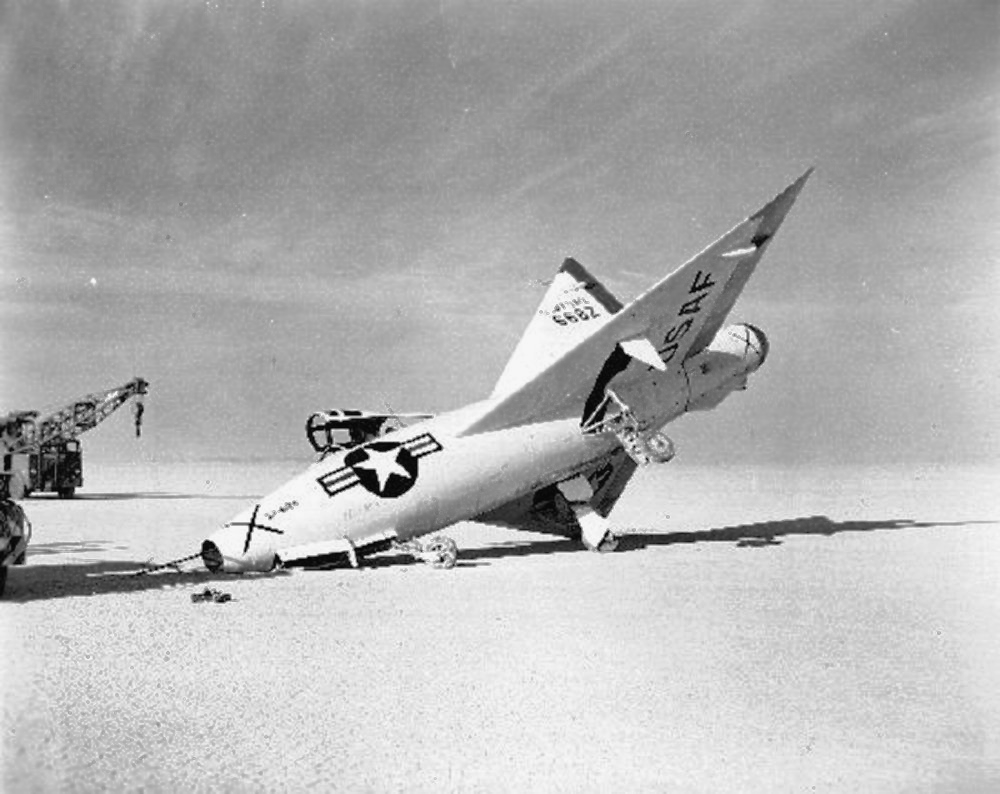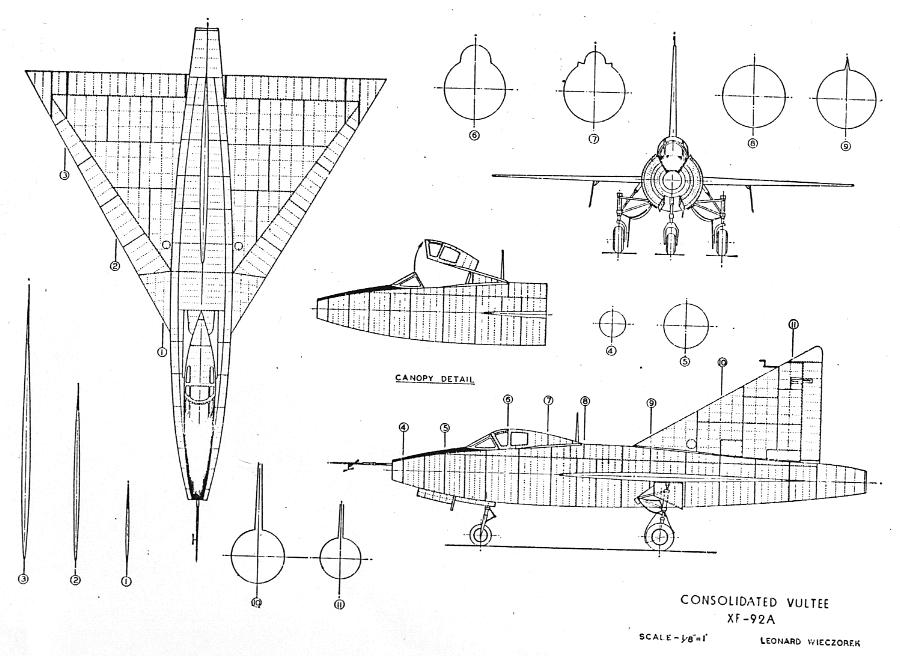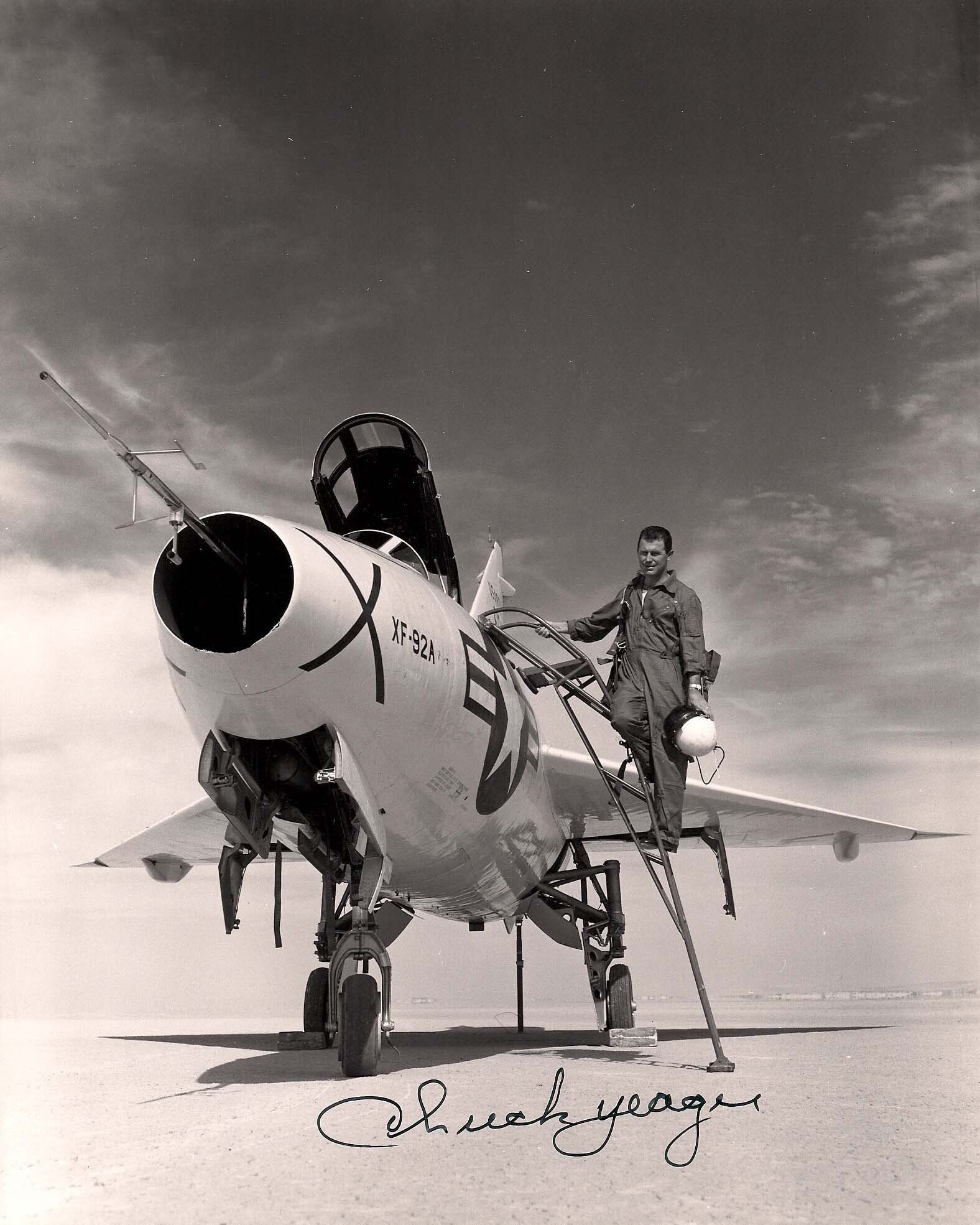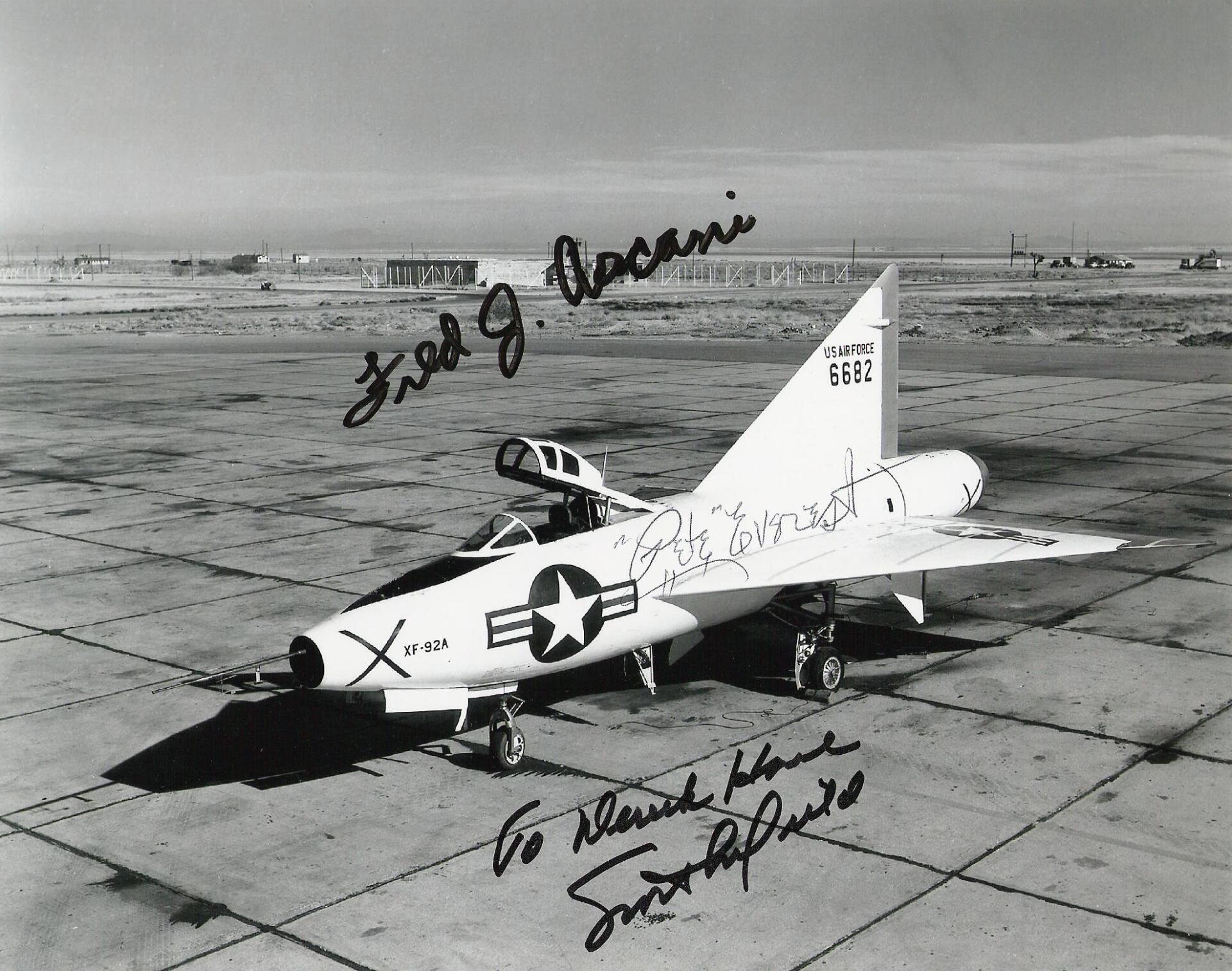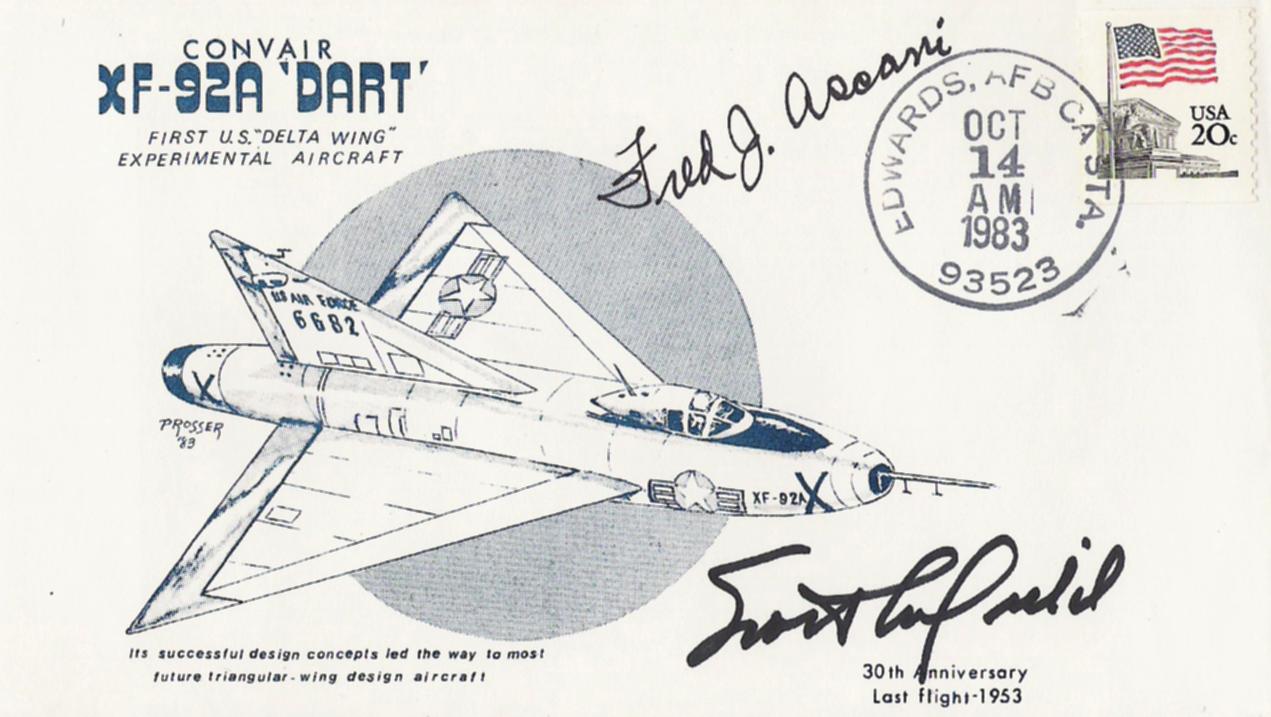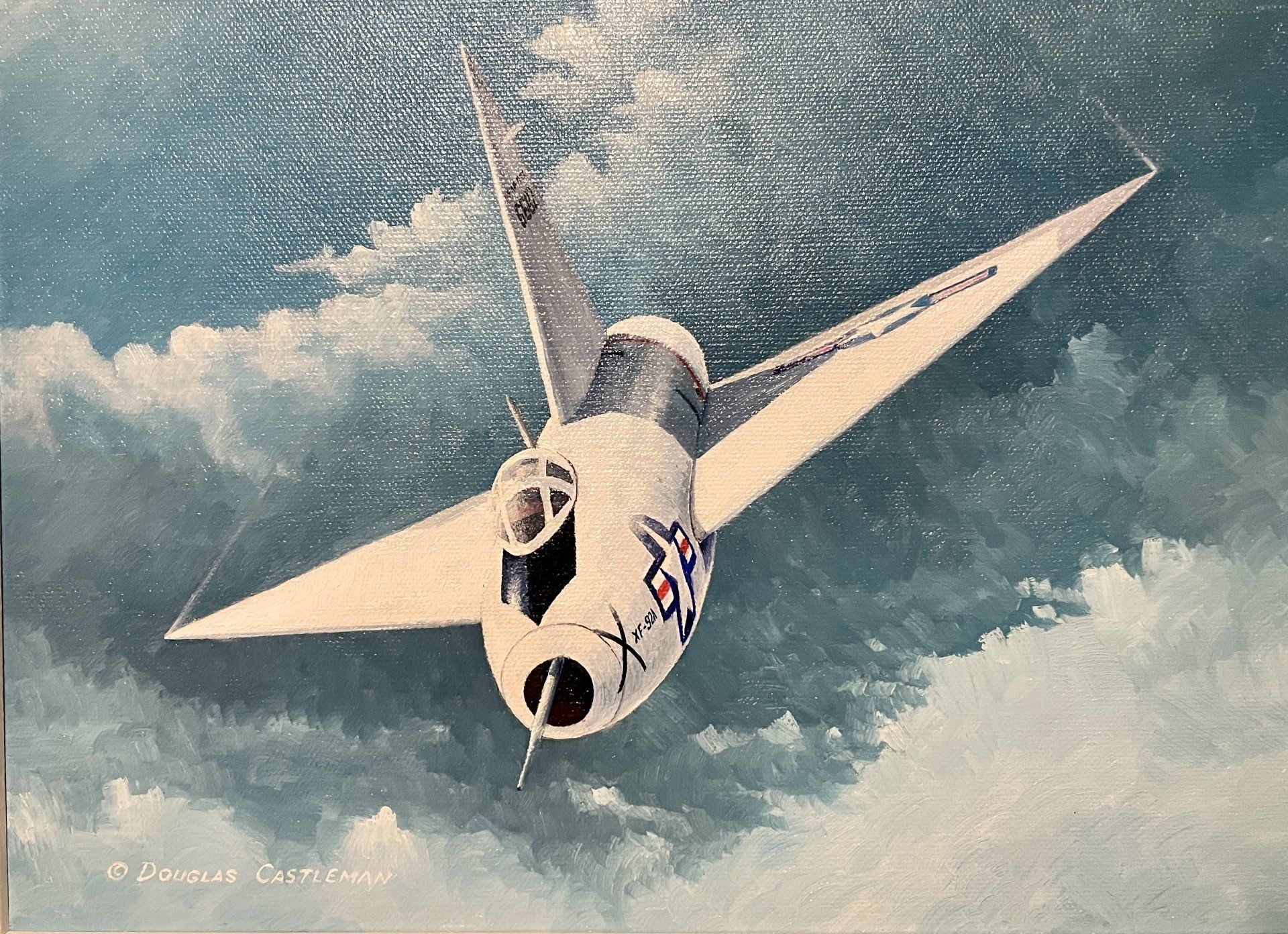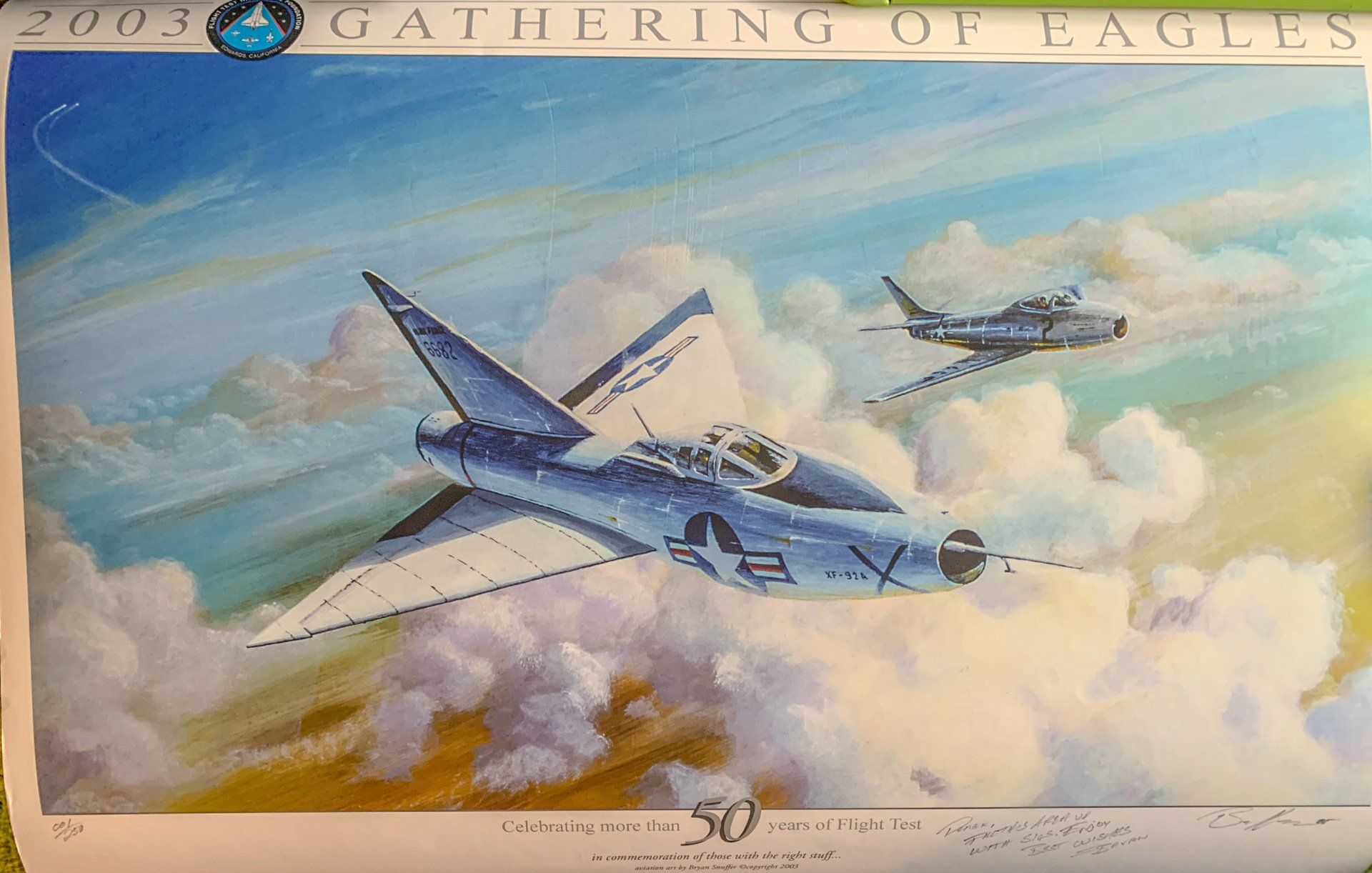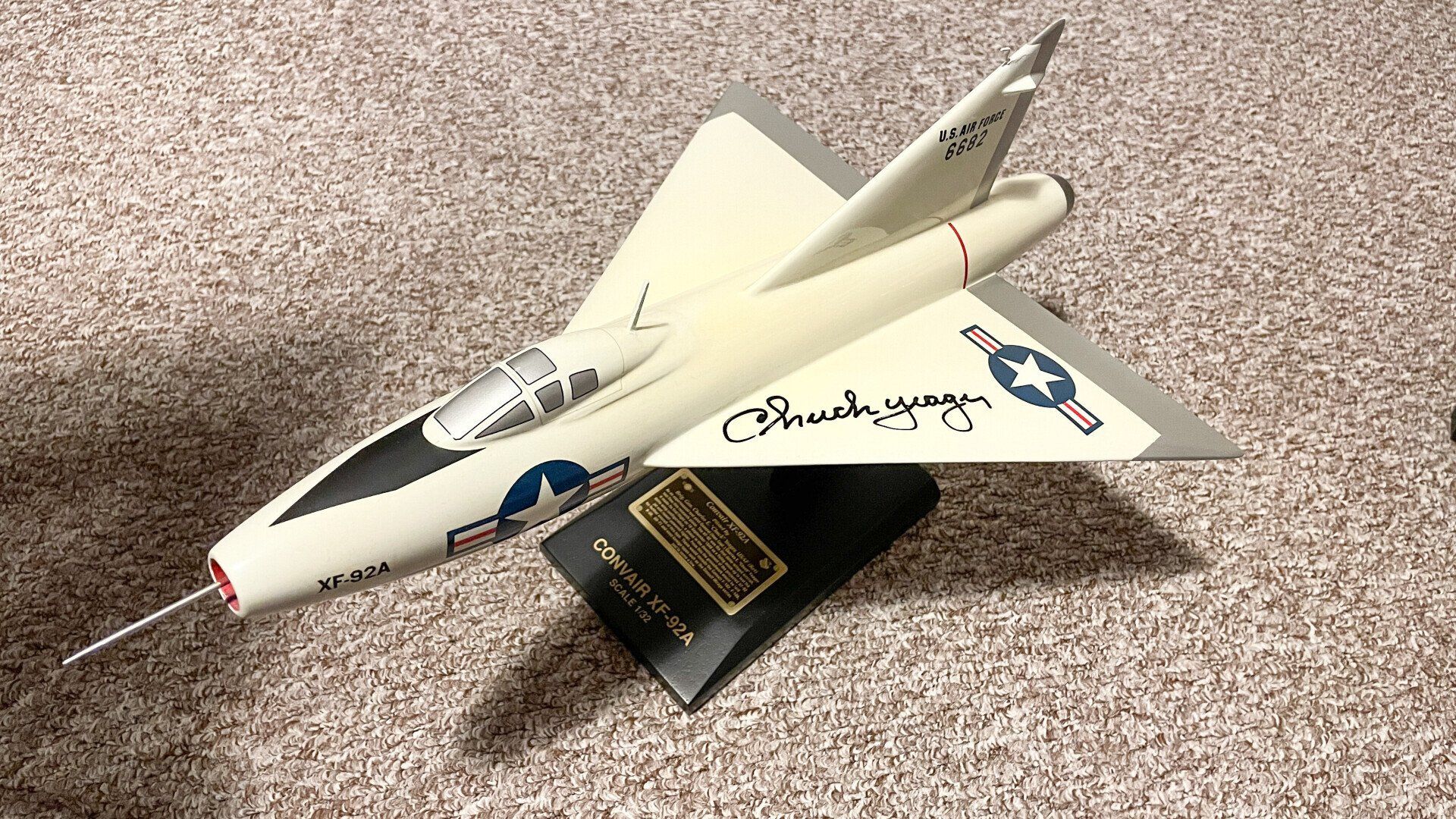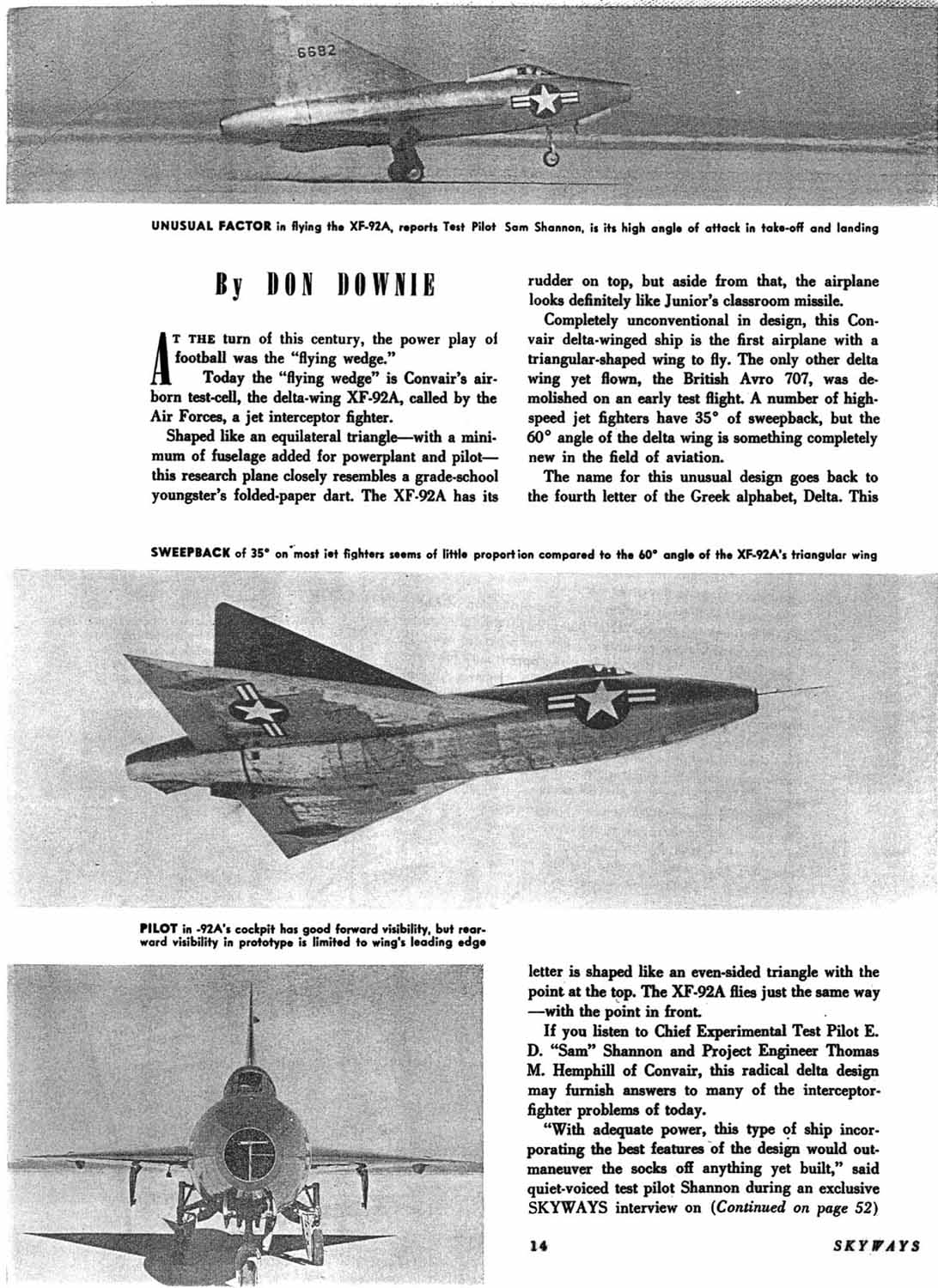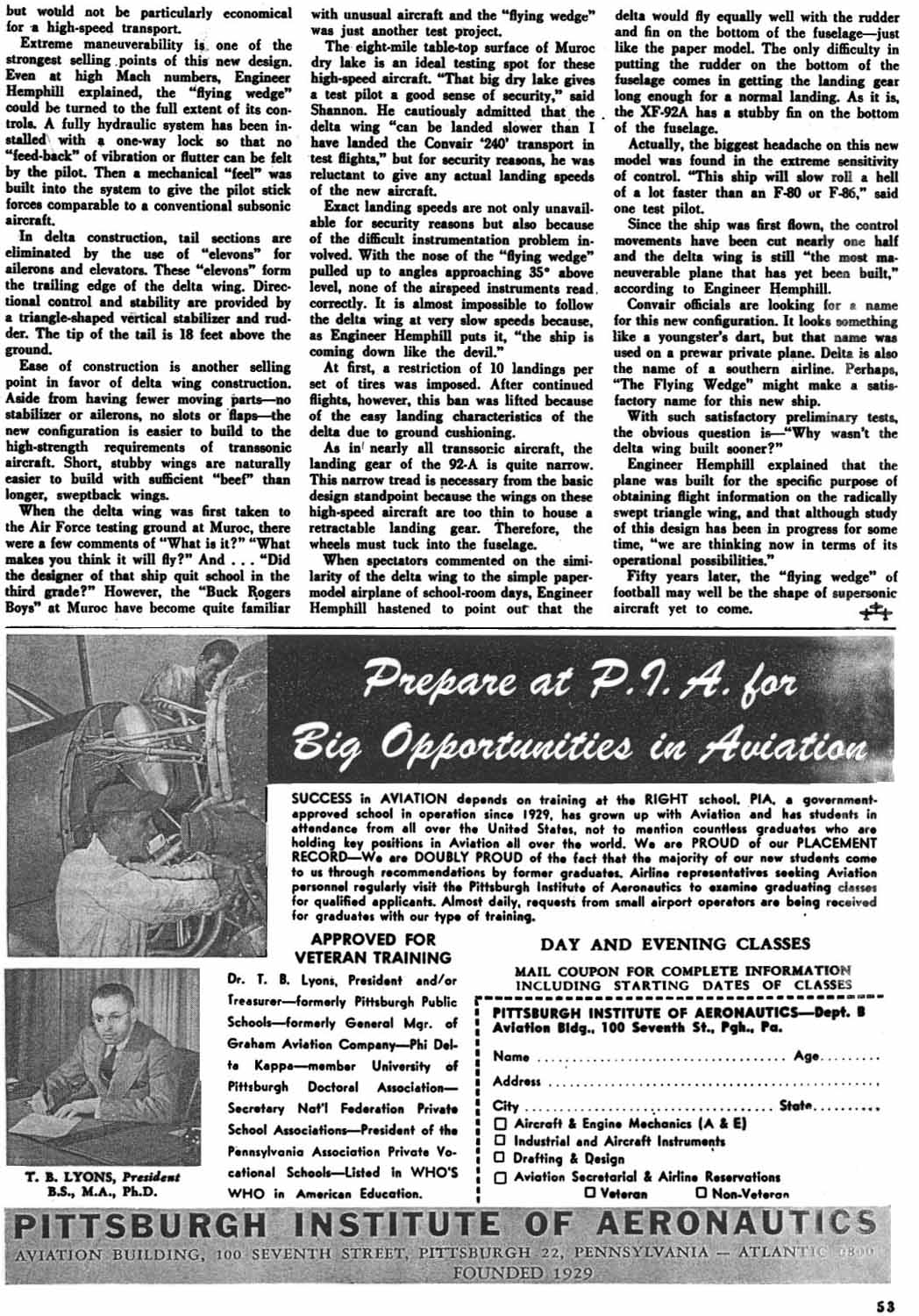Convair XF-92A
The Convair model 7002, a delta winged turbojet airplane better known as the XF-92A was the first in a long line of American Delta Winged Aircraft. The F2Y, F-102, F-106 & B-58 Hustler were all based around the flight data acquired by the flight testing of the XF-92A.
Thomas Melvin Hemphill, the Preliminary Design Engineer and Project Engineer on the XF-92A, is featured in a March 1950 Skyways article that was published when the XF-92A was first introduced to the public by Hemphill and Convair. The plane was tested at Muroc by Pilots Sam Shannon and Bill Martin and others. General Chuck Yeager tested the plane for the Air Force. Nearly 80 tests flights were flown at Muroc/Edwards prior to the publication of the Skyways article. The XF-92A was built on a low cost budget with some parts scavenged from already existing planes. The March 1950 Skyways article can be found toward the bottom of this page in its entirety. In the annals of history, Hemphill has been largely overlooked with regard to the the XF-92A. It is with sincere thanks to the late Mr. Hemphill's daughter Zoe that this article has been brought to light.
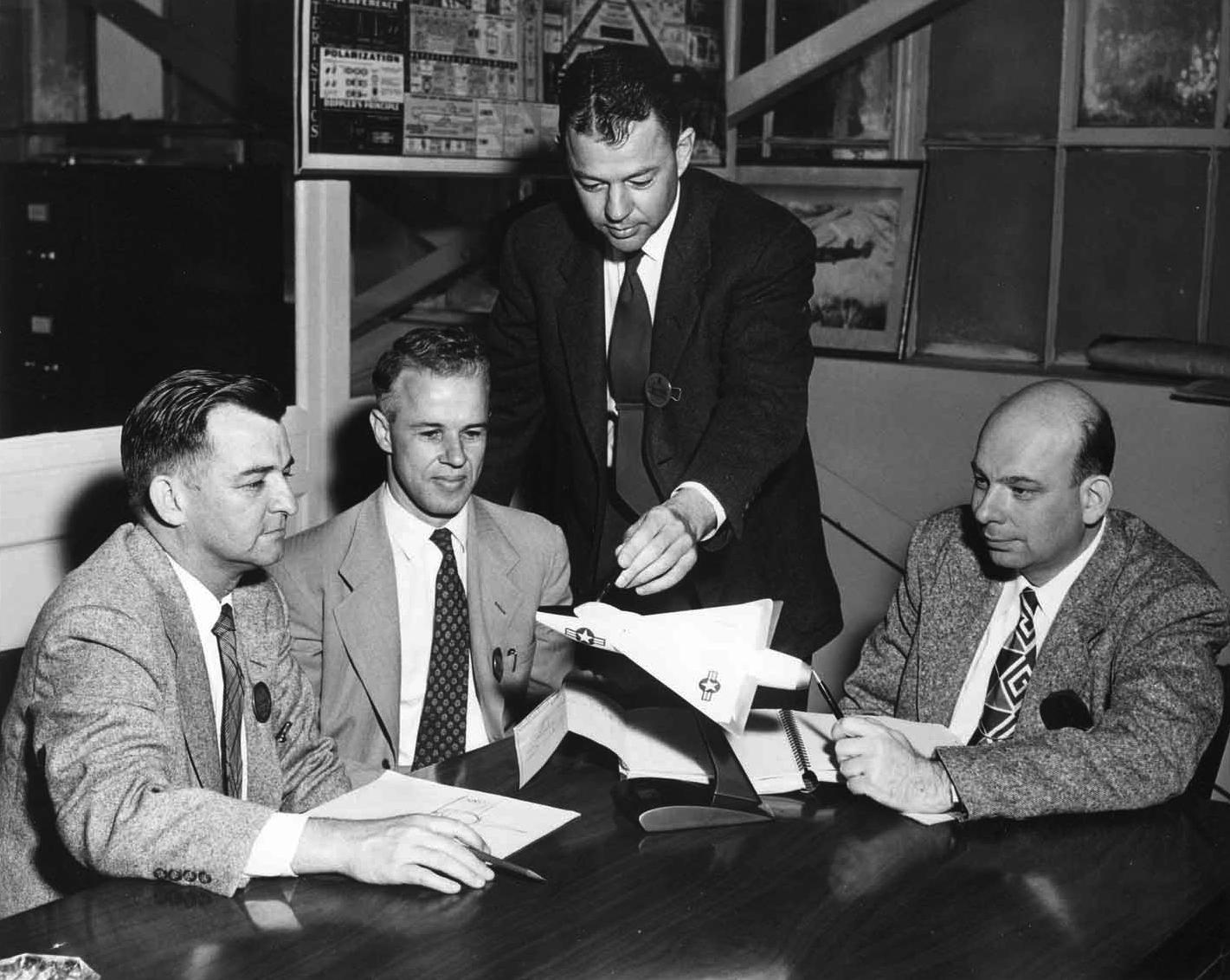
The XF-92A was a single seat, jet propelled research fighter-type land plane. Characterised by a 60º delta wing and a large vertical tail, the wing planform of the XF-92A was an equilateral triangle with a span of 31’4”. With no separate horizontal tail surfaces, the elevons (combined elevator/aileron) provided the pitch and roll control for the aircraft. One of the more unusual aspects of the XF-92A was the hydraulically boosted controls. So sensitive were they, that when Colonel Al. Boyd asked Capt. Chuck Yeager “Now Chuck, what’s the technique on flying this airplane? Just how do I go about taking it off?” Yeager replied, “Well I’ll tell you sir. You get out there, you go rolling down the runway, and when that air-speed indicator indicates 180 (knots) you just blow a little on the stick. That’s all you have to do.”. Recalling some years later, Boyd said “I rolled down the runway to 180 and when I lifted the airplane off, I’ve never touched anything so sensitive in all my life. It was almost uncontrollable because the control system was so terribly sensitive”.
Specifications
- Wingspan – 31’4”
- Length – 42’6”
- Height – 17’9”
- Weight – 14,608lbs
- Powerplant(s) – Allison J-33-A-21 (original engine when taxi tested as Convair model 7002). After brief hop on June 9th, 1948 the Allison J-33-A-23 was installed producing 3,700 lbs thrust (dry) and 4,250 lbs thrust (with afterburner). Allison J-33-A-29 installed (after engine failure on May 12th, 1950) producing 5,600 lbs thrust (dry) and 7,500 lbs thrust(with afterburner). In early April 1953 the NACA replaced the J-23-A-29 with the more powerful Allison J-33-A-16 producing 6,400 lbs thrust (dry) and 8,400 lbs thrust (with afterburner)
- Maximum Speed – 700mph (Mach 1.01)
- Cruising Speed – 655mph
- Maximum Altitude – 42,464ft
- Aircraft Serial Number – 46-682
The initial flight testing of the 7002 was conducted by Convair chief experimental test pilot Ellis D. “Sam” Shannon. During taxi trials on June 9th 1948, the 7002 leapt off the lakebed to an altitude of some 10 to 15 feet at 180mph. Shannon kept the aircraft flying for around 40 seconds and covered a distance of around 2 miles before setting the aircraft back down on the lakebed.
Following this test, Convair technicians installed a more powerful Allison J-33-A-23 turbojet, a new tail pipe and tail-cone and a high speed canopy and windshield. The XP-92 project (from which the 7002 was born) was cancelled in June 1948, which freed the sole aircraft built from the constraints of development testing. This allowed it to embark on a pure delta planform research project. The Airforce re-designated the aircraft the XF-92A to distinguish it from the cancelled XP-92 (which would have been an experimental prototype fighter powered by a rocket). Convair resumed the contractor testing in September of 1948. Sam Shannon took the XF-92A up for its first flight on September 18th, 1948. The flight lasted for 18 minutes and was basically a pilot familiarisation flight. Shannon immediately noticed that the control system was extremely sensitive and responded quickly to the most minute of control-stick deflections.
By the end of 1948, Shannon had made 10 flights in the XF-92A and another Convair pilot, Bill Martin joined the program and made his first flight on February 9th, 1949. Convair concluded the 1st phase of the flight testing on August 26th, 1949. In the 11 months of flight testing, the XF-92A made 47 flights, accumulating a total of 20 hours and 33 minutes of flying time in the hands of Shannon & Martin.
The Airforce conducted the second phase of the flight testing (stability & control). The primary pilot for this project was Capt. Chuck Yeager. Yeager made his first flight in the XF-92A on October 13th, 1949, almost exactly 2 years after he flew the Bell X-1 through the sound barrier for the worlds first supersonic flight. Maj. Frank “Pete” Everest joined Yeager on the project. Yeager & Everest both flew the aircraft through the speed of sound, all the while examining its stability & control characteristics during level flight, dives, sideslips & rolls. Yeager thought the XF-92A was a neat airplane to fly and later recalled, "The XF-92A was a step in the right direction in aircraft design. I flew it to supersonic speeds in a dive and had it as low as 67mph (in the landing pattern). The angle of attack was 44º. You just couldn’t stall the aircraft”.
Former XF-92A (Convair) Flight Test Engineer William F. Chana recalls Yeager's first flight:- Yeager was heading right for us at about 200 feet off the deck and certainly not slow enough to make a landing. He went by us at a very high speed, then pulled the nose up and made several victory barrel rolls as he turned into the downwind leg and lowered the gear. He made a perfect landing. As he climbed down the ladder from the cockpit Yeager exclaimed, "Oh my goodness, just give me an airplane like this with F-86 performance and guns and I'll knock anything out of the sky. Sam (Shannon) walked up to Yeager and said, "Chuck, didn't you find the airplane a little sensitive to fly?". Yeager snapped back, "No. Its ok! This is a beautiful bird! Let's get on with the test program". That was the start of the Airforce flight test program of the worlds first delta wing. During the Phase II test program, the XF-92A flew supersonically only once, Everest diving through the sound barrier in late December 1949.
Airforce pilots who made familiarisation flights in the XF-92A were Lt. Col. Fred J. Ascani, Col. Albert Boyd, Lt. Col. Richard L. Johnson, Capt. J.E. Wolfe, Capt. Arthur “Kit” Murray and Maj. Jack Ridley.
The NACA’s Scott Crossfield made the 1st of his 25 flights (with the J-33-A-16 engine installed) on April 9th, 1953 with Chuck Yeager flying chase in an F-86 Sabre jet. Like all the other pilots who had flown the XF-92A, Crossfield found the controls to be sensitive. Crossfield’s last flight in the aircraft was made on October 14th, 1953. After touching down on the lakebed, the drogue ‘chute was deployed and jettisoned & Crossfield began to taxi back to the runway, as he slowed the plane near the end of its run, the XF-92A’s nose began to drop and it slewed around in a hard left turn. The plane settled on its nose, right landing gear & right wingtip. Crossfield crawled out of the cockpit after ascertaining that the aircraft was not about to turn over. Inspection showed that the nose strut attachment had failed during the taxi run and the cocked gear strut in turn caused the shock strut to buckle and fold up, slewing the plane around.
This was a rather ignominious end to the XF-92A’s flight career. During its 5 years of flying, the XF-92A had logged 119 flights with approximately 62 hours of flying time. The XF-92A is on permanent display at the USAF Museum, Dayton Ohio.
XF-92A Photo Gallery below
Skyways Magazine Article about the XF-92A - Courtesy of the T.M Hemphill Family Collection

